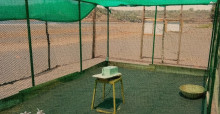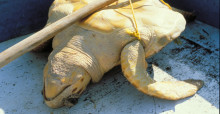Dar es Salaam, United Republic of Tanzania, 27 June 2024 – Governments, scientific experts and stakeholders gathered o
Lepidochelys olivacea
The olive ridley turtle (Lepidochelys olivacea) is considered the most abundant sea turtle in the world, with an estimated 800,000 nesting females annually. Adults are relatively small, weighing on average around 45 kg. As with other species, their size and morphology varies from region to region. The olive ridley is omnivorous, feeding on algae, lobsters, crabs, tunicates, mollusks, shrimp, and fish.
The olive ridley is globally distributed in the tropical regions of the South Atlantic, Pacific, and Indian Oceans. It is mainly a pelagic species, but it has been known to inhabit coastal areas, including bays and estuaries; where they can dive to depths of about 150 m to forage on benthic invertebrates. Olive ridleys often migrate great distances between feeding and breeding grounds. They mostly breed annually, involving an annual migration from pelagic foraging, to coastal breeding and nesting grounds, back to pelagic foraging. Olive ridleys reach sexual maturity in around 15 years, a young age compared to some other sea turtle species. Many females nest every year, once or twice a season, laying clutches of approximately 100 eggs.
In certain places, the olive ridley has one of the most extraordinary nesting habits in the natural world. Large groups of turtles gather off shore of nesting beaches. Then, all at once, vast numbers of turtles come ashore and nest in what is known as an "arribada". During these arribadas, hundreds to thousands of females come ashore to lay their eggs. In the northern Indian Ocean, arribadas occur on three different beaches along the coast of Orissa, India. Gahirmatha used to be one of the largest arribada nesting sites in the world. However, arribada nesting events have been less frequent there in recent years and the average size of nesting females has been smaller, indicative of a declining population. Declines in solitary nesting of olive ridleys have been recorded in Bangladesh, Myanmar, Malaysia, and Pakistan. In particular, the number of nests in Terengganu, Malaysia has declined from thousands of nests to just a few dozen per year. Solitary nesting also occurs extensively throughout this species' range.
Despite the enormous numbers of olive ridleys that nest in Orissa, India, this species is not generally common throughout much of the Indian Ocean. Its pelagic habits make it especially subject to interactions with modern fisheries, such as longlines. Coastal trawl and net fisheries are also important sources of incidental catch and mortality.
The preceding biological information on marine turtle species found around the Indian Ocean is derived partly from the NOAA Fisheries, Office of Protected Resources, website:(http://www.nmfs.noaa.gov/pr/species/turtles/), supplemented by other sources (such as a website of the Australian Government, Department of Environment, Water, Heritage and the Arts -- for information on the Flatback turtle), and additional information supplied by Dr. Jack Frazier (IOSEA Advisory Committee Chair).
| CMS Instruments | CMS, IOSEA Marine Turtles, Atlantic Turtles |
|---|---|
| IUCN Status | Vulnerable |
| Date of entry in Appendix I | 1985 |
| Date of entry in Appendix II | 1979 |
| English | Ridley Turtle, Olive Ridley Turtle |
|---|---|
| French | Tortue Batarde |
| Spanish | Tortuga olivácea |
| German | Bastardschildkröte |
| Class | Reptilia |
|---|---|
| Order | Testudinata |
| Family | Cheloniidae |
| Scientific name | Lepidochelys olivacea |
| Author | (Eschscholtz, 1829) |
| Standard reference | Eckert, K.L., Bjorndal, K.A., Abreu-Grobois, F.A. and Donnelly, M. (Eds) (1999). Research and management techniques for the conservation of sea turtles. IUCN/SSC Marine Turtle Specialist Group Publication No.4. |
| Additional notes | All migratory Cheloniidae spp. |
|---|











